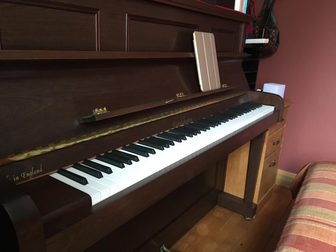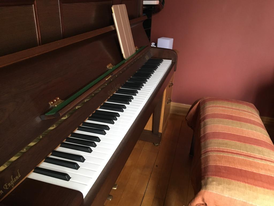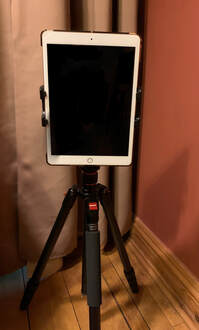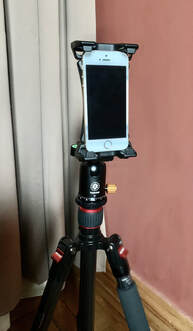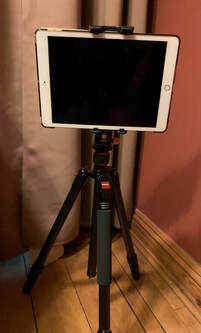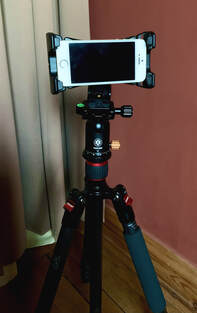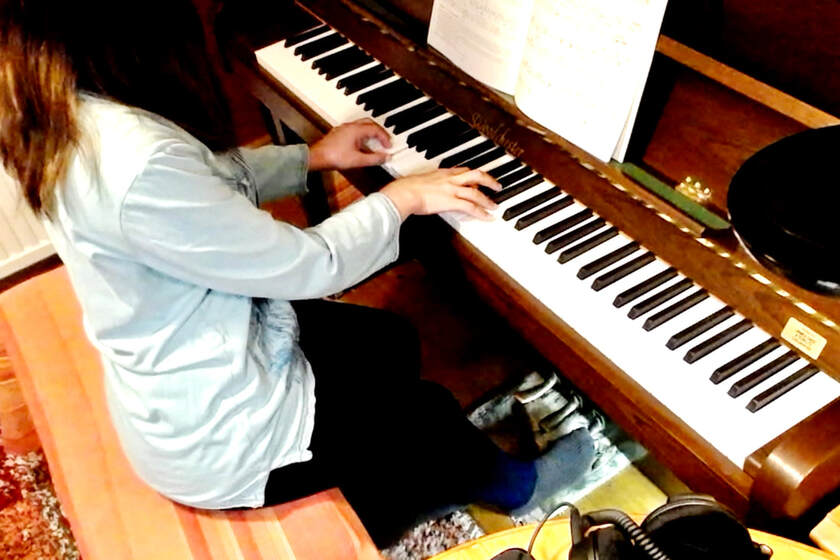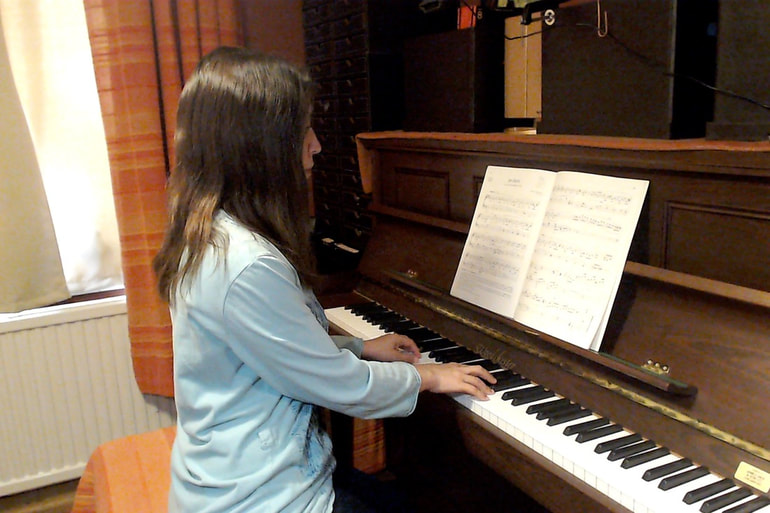Piano lessons via Zoom, Skype, FaceTime and other video calling apps - advice for setting up.
During your video call lessons, you will need to prop up your device in such a way that I can see your hands on the piano keyboard as well as you (or if setting up for your child, please ensure I can see your child’s hands on the keyboard as well as him/her). Slightly diagonally to the side usually works best, high enough to be slightly angled downwards looking onto the keys, and not too close in order to get both the keyboard and the upper body of the pupil into the frame.
If you use a tablet or phone for the video calls, a stand or tripod for holding it in the ideal position is usually best. Something like a gooseneck tablet/phone holder which clamps onto a nearby table or shelf can be helpful. A music stand can sometimes work well. The kind of protective case for iPads that converts into a stand is usually not suitable because it will result in the iPad being angled backwards and the camera will be “looking” towards the ceiling. You need a holder that will allow a slight downwards tilt. Sometimes these holders will fit an iPad that is kept in a protective case, so you may not need to worry about taking it out of its case each time. These sorts of holders are commonly advertised as being suitable for watching your tablet hands free whilst reclining in bed. Some table top stands also allow a slight downward tilt.
If you’re using a laptop, some people find an ironing board or a few books piled on a table helps to get a suitable height. The screen of a laptop is usually easy to tilt downwards in order to get a suitable camera angle.
The following pictures show some possible camera angles you can aim for.
If you use a tablet or phone for the video calls, a stand or tripod for holding it in the ideal position is usually best. Something like a gooseneck tablet/phone holder which clamps onto a nearby table or shelf can be helpful. A music stand can sometimes work well. The kind of protective case for iPads that converts into a stand is usually not suitable because it will result in the iPad being angled backwards and the camera will be “looking” towards the ceiling. You need a holder that will allow a slight downwards tilt. Sometimes these holders will fit an iPad that is kept in a protective case, so you may not need to worry about taking it out of its case each time. These sorts of holders are commonly advertised as being suitable for watching your tablet hands free whilst reclining in bed. Some table top stands also allow a slight downward tilt.
If you’re using a laptop, some people find an ironing board or a few books piled on a table helps to get a suitable height. The screen of a laptop is usually easy to tilt downwards in order to get a suitable camera angle.
The following pictures show some possible camera angles you can aim for.
Possible camera angles for students to aim for:
It doesn’t matter which side of the piano you place the device.
If you are using a phone or tablet, please avoid positioning your device in portrait orientation if possible. Landscape orientation is best, and will ensure both of us will have a better view. I.e. don’t position your device vertically like this:
Position it horizontally like this:
Many phone and tablet holders (particularly the ones attached to a gooseneck arm) can rotate through 360 degrees so that you can easily select portrait or landscape mode just by turning the device. If you are using a tripod with a three way pan-tilt head, or a ball head; again it is possible to position the device in either landscape or portrait orientation with a bit of adjustment.
When using a phone or tablet, please ensure your rotation lock (orientation lock) is switched off. This is normally switched off by default.
Some of the camera angles I use for demonstrations:
During Zoom, Skype and FaceTime piano lessons (and other video call lessons), I use multiple webcams so that pupils can get an overhead view of my hands on the keys when I demonstrate; or a very close up view if they need to see more detail: or a side view if they need to see hand, wrist and arm positions. I can also give a view of the pedals when necessary. However you don’t need to worry about giving me a close up view of your keyboard, I will be able to see enough with the sorts of views in the pictures above. The sorts of views in the examples above will ensure I can see the pupil’s use of fingering, hand / wrist position, and technique.
Here is are two examples of views I give during the lessons when pupils need to see demonstrations more closely:
If I need to demonstrate pedalling, I often give this sort of view:
The following view is useful for demonstration of sitting position and arm/wrist positions, as well as general demonstrations:
Zoom audio settings - background noise suppression must be switched off
For Zoom piano lessons, I will send you a link for my personal meeting room, and you can use the same link every time. Once we have booked a lesson, you just need to follow the link at the booked time. This link will take you to a waiting room where you can wait for me to let you in. Then follow the on-screen instructions to connect to audio so that we can hear each other.
If you are using a laptop for Zoom calls, please check your audio settings beforehand. Under "suppress background noise", please ensure that "low" is selected. If the setting is on auto, medium or high, this can result in the sound of the piano being treated as background noise and suppressed.
If you don't have this particular setting, you can select "original sound", or "original sound for musicians". Once "original sound for musicians" is enabled, you will need to switch it on in the main screen at the start of every meeting (usually this option is easily found in the top left of the screen). Enabling "original sound" in the audio settings just allows you to quickly toggle between "original sound for musicians on" and "original sound for musicians off"* on the main screen during the meeting, it doesn't automatically switch on original sound. At the start of every meeting, "original sound for musicians" will be off by default, you simply need to click on where you see "original sound for musicians off" in order to switch it on (this is made possible by the earlier step in the audio settings described above).
*("Original sound for musicians off" gives "Zoom optimised audio" which suppresses background noise, including the sound of the piano.)
If you are using a phone or tablet for the Zoom calls you will need to go into your settings and enable "original audio" or "original sound". For step by step instructions on how to enable "original audio" or "original sound on a phone, click here. The steps are similar for a lot of tablets.
You can also find Zoom's own instructions for enabling original sound on various different devices here: Zoom original sound
For Skype or FaceTime lessons we will need to exchange Skype or FaceTime IDs. Your Skype or FaceTime ID might be a phone number, email address or a Skype user name. For Skype or FaceTime piano lessons I will call you at the booked time (the same applies for WhatsApp, Messenger and Hangouts). When accepting a Skype call, you will need to switch your camera on, because it is switched off by default for the recipient of the call on certain devices. On a touchscreen such as a phone or tablet, you just press the camera icon.
The Zoom and Skype apps are free to download. FaceTime is automatically included on your device for free if you use an iPhone, iPad or Apple Mac.
If you are using a laptop for Zoom calls, please check your audio settings beforehand. Under "suppress background noise", please ensure that "low" is selected. If the setting is on auto, medium or high, this can result in the sound of the piano being treated as background noise and suppressed.
If you don't have this particular setting, you can select "original sound", or "original sound for musicians". Once "original sound for musicians" is enabled, you will need to switch it on in the main screen at the start of every meeting (usually this option is easily found in the top left of the screen). Enabling "original sound" in the audio settings just allows you to quickly toggle between "original sound for musicians on" and "original sound for musicians off"* on the main screen during the meeting, it doesn't automatically switch on original sound. At the start of every meeting, "original sound for musicians" will be off by default, you simply need to click on where you see "original sound for musicians off" in order to switch it on (this is made possible by the earlier step in the audio settings described above).
*("Original sound for musicians off" gives "Zoom optimised audio" which suppresses background noise, including the sound of the piano.)
If you are using a phone or tablet for the Zoom calls you will need to go into your settings and enable "original audio" or "original sound". For step by step instructions on how to enable "original audio" or "original sound on a phone, click here. The steps are similar for a lot of tablets.
You can also find Zoom's own instructions for enabling original sound on various different devices here: Zoom original sound
For Skype or FaceTime lessons we will need to exchange Skype or FaceTime IDs. Your Skype or FaceTime ID might be a phone number, email address or a Skype user name. For Skype or FaceTime piano lessons I will call you at the booked time (the same applies for WhatsApp, Messenger and Hangouts). When accepting a Skype call, you will need to switch your camera on, because it is switched off by default for the recipient of the call on certain devices. On a touchscreen such as a phone or tablet, you just press the camera icon.
The Zoom and Skype apps are free to download. FaceTime is automatically included on your device for free if you use an iPhone, iPad or Apple Mac.
Ensuring a good connection during video calls:
If you are using Wi-Fi for the video calls, it is best to make sure your device is as close to the router as possible. If the router is on the other side of the house, this can result in a weaker signal, especially if the signal has to travel through metal or concrete. If possible, it is also best to ensure that other members of the household are not doing anything too internet heavy during your video calls. If other members of the household are on video calls at the same time, this can use up bandwidth and result in a poor quality call.
It can also help to make sure that you don't have too many apps open on your phone, tablet or laptop during the video calls.
It can also help to make sure that you don't have too many apps open on your phone, tablet or laptop during the video calls.
You can read more about video call piano lessons here.
You can read about an alternative option for online piano tuition here: video exchange piano lessons.
Lesson fees
You can read about an alternative option for online piano tuition here: video exchange piano lessons.
Lesson fees
